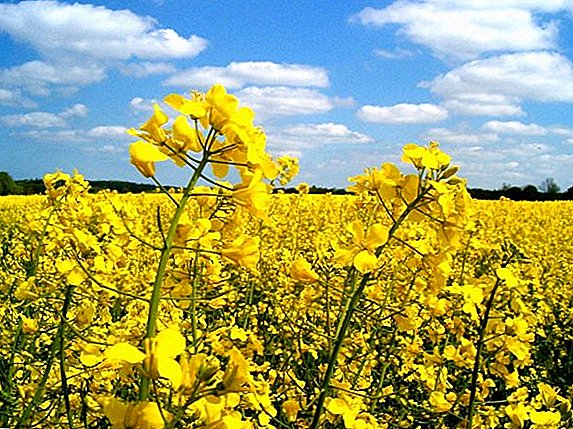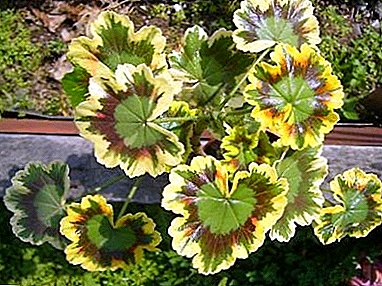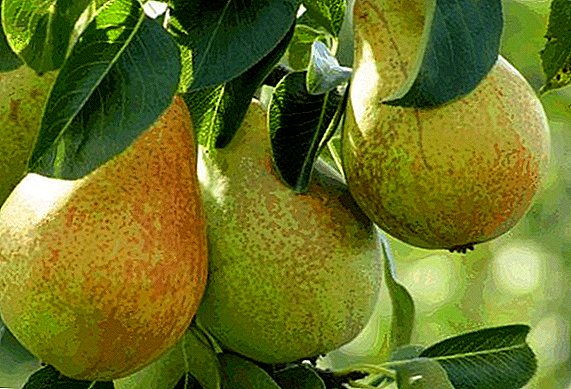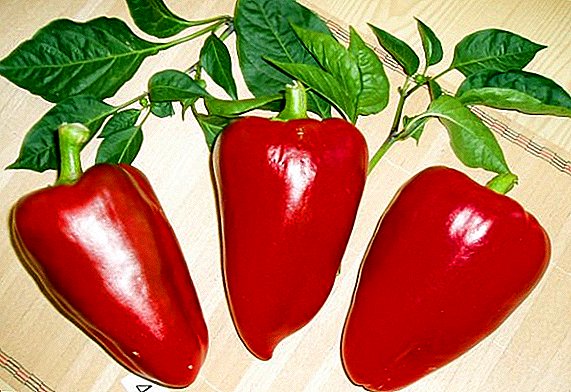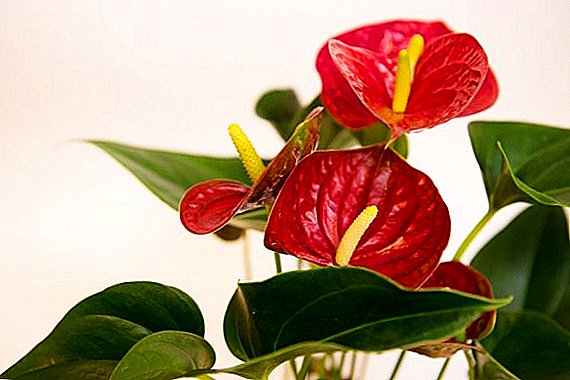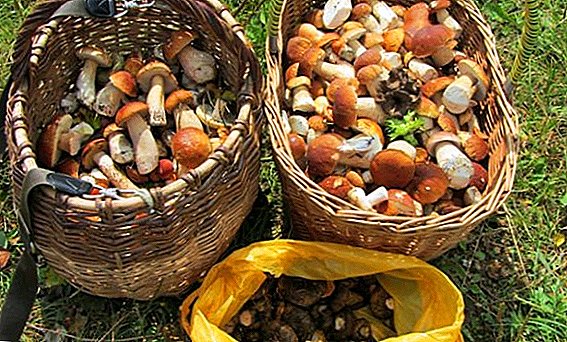 Every year in the world there are several hundred new varieties of tomatoes that are immune to diseases, as well as improved yields. Both beginners and experienced farmers have almost unlimited choice, not limiting themselves to several varieties of tomatoes. Today we will consider the tomato "Tsunami", we will tell about its strengths, as well as about planting and growing.
Every year in the world there are several hundred new varieties of tomatoes that are immune to diseases, as well as improved yields. Both beginners and experienced farmers have almost unlimited choice, not limiting themselves to several varieties of tomatoes. Today we will consider the tomato "Tsunami", we will tell about its strengths, as well as about planting and growing.
Variety description
This tomato is popular among gardeners due to the high yield and good taste of the fruit.
The appearance of the bushes
This is a mid-early variety of tomatoes, which has a determinant shrub 50-60 cm high, in the process of growth can go 1 or 2 stems. Sheet plates are painted in light green color, have weak ribbing. Faceliness is medium, bushes are weak branching. In the process of growing need a garter.
On one plant up to 6 brushes are formed, on each of which 3-5 fruits ripen.
Among the determinant tomatoes can be distinguished varieties "Raspberry Giant", "Klusha", "Chocolate", "Rio Fuego", "Riddle", "Stolypin", "Sanka", "Apparently Invisible", "Lazyka", "Torbay F1" , "Pink Bush F1", "Bobcat", "Bokele F1", "Liana", "Primadonna", "Newbie", "Balcony Marvel", "Chio-Chio-San".
Fruit characteristics and yield
Tomatoes are painted in dark pink. The spot near the fruit stem is missing. The shape is flat-rounded; in some specimens, there is a weak ribbing in the region of abutment of the stem. The average weight of tomatoes is 250-300 g when grown in a greenhouse and about 150-180 g in open ground.

The first fruits ripen on 105-110 days after germination. The average yield per bush is 3-3.5 kg, provided all the necessary mineral fertilizers are applied during the growing season.
The fruits are consumed fresh, as well as in the composition of summer salads. Sweet tomatoes make delicious juices.
Tasty juices and salads come out of tomatoes "One hundred pounds", "Slot f1", "Japanese Crab", "Golden Domes", "Monomakh's Cap".
Advantages and disadvantages
Pros:
- the big fruits having an excellent trade dress;
- good taste of tomatoes;
- high yield.
- Tomatoes are affected by blight;
- fruits are unsuitable for preservation;
- poor transportability due to thin delicate skin.
Did you know? The composition of tomatoes of any sort includes serotonin - the hormone of happiness, which improves mood, and also has a weak analgesic effect.

Agrotechnology
The grade "Tsunami" is grown up both in open, and in the closed ground. Film shelter is not required when grown in southern areas of temperate climate.
Growing seedlings
Seedlings are sown 50-60 days before picking into open ground or a greenhouse. If you plan to plant tomatoes in a covered ground, then the seedlings should be dealt with in the middle and end of February, while in the open ground - in the middle and end of March.
Learn how to prepare the soil for seedlings, how to disinfect it, how to save space, how to grow seedlings without soil.
Substrate
Before sowing seeds should take care of the purchase or preparation of the substrate. The prepared soil is poured into prepared boxes or taken from garden soil, disinfected (heated), and then mixed with compost and a small amount of mineral water.
It is important to ensure that the substrate was not only nutritious, but also quite loose, otherwise young plants can rot the roots.

Sowing seeds
Pre-soil in the boxes moistened, and then make a small furrow depth of 0.5 cm. The distance between adjacent grooves should be at least 4-5 cm. Then, every 2 cm put 1 seed. Seed germination is good, so you should not initially make a dense planting.
After sowing, soil is equal and moistened again, then covered with foil. It is important that the shelter is not tight, so immediately make a few small holes in diameter, through which air will flow to the substrate.
Familiarize yourself with the timing of planting tomatoes, picks, feeding seedlings, planting in open ground.
Care
Boxes should be located near heating appliances or batteries so that shoots appear earlier. The temperature should be within + 20 ... +25 ° С. In such conditions, the first greens will appear within a week.
After the shoots seem, boxes of seedlings are moved to a place well illuminated by the sun. If there is none, then you should take care of good artificial lighting, which requires incandescent bulbs with a “warm” light.
In the next two weeks, it is necessary to provide daytime temperature within + 15 ... +16 ° С and nighttime at least 12 ° С. The optimal light day is 11-12 hours.

Important! As soon as the first shoots seem, the film cover must be completely removed, otherwise the plants will “suffocate”.For the third week after the first shoots, the temperature in the room where the seedlings are grown, is raised to + 20 ... +22 ° С during the day, and to + 16 ... +17 ° С at night, in order to accelerate the growth and development of the bushes.
Pretransplant
When young tomatoes appear 2-3 true leaves (non-cotyledonous), it dives into separate cups. You can take a half-liter plastic cups or small pots for indoor plants. If you want to grow tomatoes in boxes before planting in the ground, then transplant them so that there is at least 10 cm distance between neighboring plants.
Before picking the soil should be moistened, which will help to avoid damage to the root system. It is also important to ensure that the new substrate is not very different in composition and drainage properties from the past.
In order to avoid growth inhibition after transplantation, it is recommended to apply a small amount of nitrogen fertilizers. However, it is important to understand that if the bushes already have a considerable mass of the green part, such a fertilizer can adversely affect the fruiting period, as well as the quality and quantity of tomatoes. Nitrogen fertilizer is applied in the event that plants lag behind in development.

In such conditions, tomatoes are grown before diving to a permanent place. 1-2 weeks before the proposed landing in open / closed ground, it is recommended to harden the seedlings.
To do this, it is necessary to gradually lower the temperature to that which corresponds to the air temperature on the street or in the greenhouse. This is necessary in order to avoid diseases that arise due to the transfer of seedlings from heat to cold.
Dive to a permanent place
The seedlings are planted in a permanent place at 50-60 days, but this is only an approximate framework, so you should not dive the seedlings if they have a painful appearance or the above-ground part is poorly developed.
First you need to prepare the soil: apply humus or compost, mineral fertilizers, and loosen it so that the root system of tomatoes has access to oxygen.
The bushes swoop according to the 60x40 scheme, that is, 40 cm should be retreated between neighboring plants in a row, and 60 cm between rows, all watered and tied to a peg.
Learn how to plant tomatoes in the greenhouse and open ground.

If it is sunny outside, it will be useful to cover the tomatoes with grass, leaves or material that allows oxygen to pass for a day. This is necessary so that just transplanted bushes do not lose a large amount of moisture through the above-ground organs.
If seedlings are planted in the greenhouse, then you need to create optimal conditions before picking. Soil moisture should be about 70-80%, and air humidity - 60-65%. Such indicators allow seedlings to acclimatize more quickly in a new place.
Tomato care
Caring for tomatoes in the greenhouse and in the open field varies greatly. This is due to the fact that in a closed room the problem is a sharp increase in humidity, as well as the formation of condensate. For this reason, the greenhouse must be regularly ventilated and equipped with a hood.
Important! In greenhouse conditions, the bushes are grown at a temperature of + 18 ... +24 °Happy, and + 15 ... +18 °With the night. Severe drops will cause the appearance of disease.

Watering
Tomatoes can survive a short-term drought, provided that they are healthy and have access to all nutrients. At the same time to prevent the drying of the soil is not worth it. Watering is carried out in the morning or evening hours, moistening the soil so that it remains loose, and does not turn into a homogeneous mass.
Mulching
Mulch is placed both in greenhouses and in open ground. This saves time for weeding and loosening, reduces water consumption for irrigation, prevents rotting of fruits that are in contact with the soil, and also prevents the substrate from drying out.
Straw, sawdust and needles are used as mulch. You can cover the special material, but it is quite expensive in the presence of a large squared plantings.
Learn how to mulch tomatoes in the greenhouse and garden beds, how to choose a covering material.

Forming a bush
Tomato "Tsunami" form in 1 or 2 shoots. Remove new stepchildren as soon as possible to save plant resources. The procedure for removing dry leaves and stepsons is carried out only in the morning, after which the plants do not water the day.
Learn more about tomato pasynkov.
Top dressing
Every 1.5 weeks after the dive, the tomatoes are fed to a permanent place with liquid fertilizers. Under each bush make no more than 1 liter solution of mullein, diluted in water 1 to 10. This feeding is made before the appearance of the ovaries.
After make mineral fertilizers, in which there is a large proportion of potassium and phosphorus. From nitrogen fertilizing must be abandoned in order not to lose the lion's share of the crop.
Important! All fertilizers are applied only after watering.
Video: how to feed tomatoes
Diseases and pests
The main diseases that affect this variety of tomatoes are phytosporosis and cladosporioz.
Phytosporosis - It is a fungal disease of plants that can be transmitted from one solanaceous crop to another at close range.
- Causes of appearance: high humidity, insufficient care, the presence of infected plant residues in the area.
- Symptoms: leaves, shoots and stalk begin to turn black and dry, after which the ripe and green fruits are covered with black sores and rot.
- Treatment: Fitosporin, Bordeaux mixture, copper oxychloride, and similar drugs.
- Prevention: Correct crop rotation (do not plant the nightshade at the same place), processing of tools, presowing treatment of seeds with potassium permanganate.

Cladosporiosis - A fungal disease that most often affects tomatoes and cucumbers.
- Causes of appearance: too high air humidity (fog), poor care, infection from neighboring plants.
- Symptoms: spots on the back and front of the leaves, which eventually affect the entire plate, after which dying occurs.
- Treatment: treatment of landings with any copper-containing preparations.
- Prevention: control of air humidity in the greenhouse, the correct mode of irrigation, thinning of plantings.

As for pests, tomatoes are "traditionally" affected by various insects, such as aphids, spider mites, and also scale insects. They can be destroyed by any insecticide. You can also use a soap solution or an aqueous solution of wood ash.
Did you know? During heat treatment, the fruits do not lose their beneficial properties, but, on the contrary, they turn into a form that is better absorbed by the human body.Grow a tomato "Tsunami" at home is quite simple, if you take into account all the risks, as well as to proceed not only from the instructions, but from the actual state of the plants. Remember that this variety can not be sown directly into the ground, as the young plants will be destroyed by fungus.
Variety of tomato "Tsunami": reviews
High yield!
Disadvantages:
not
I continue to share with you good varieties of tomatoes, if someone is going to plant seedlings himself.
This year I also purchased the seeds of Gavrish’s Tsunami tomato. The name speaks for itself - there will be tomatoes like a tsunami))) big, large and many)))
This variety has always been planted by my mother, so this variety has been tested for years. The seeds sprout well, with proper watering and care, the seedlings grow strong enough and strong. Well tolerated transplant in open ground.
Planted seedlings need a sufficiently lit place.
You can sow them now in March. The variety is middle-ripening 111-117 days.
Fruits usually turn out equal, large and average.
These tomatoes are perfect for salad and salting.
I wish you a great harvest!
Overall impression: Checked grade!




